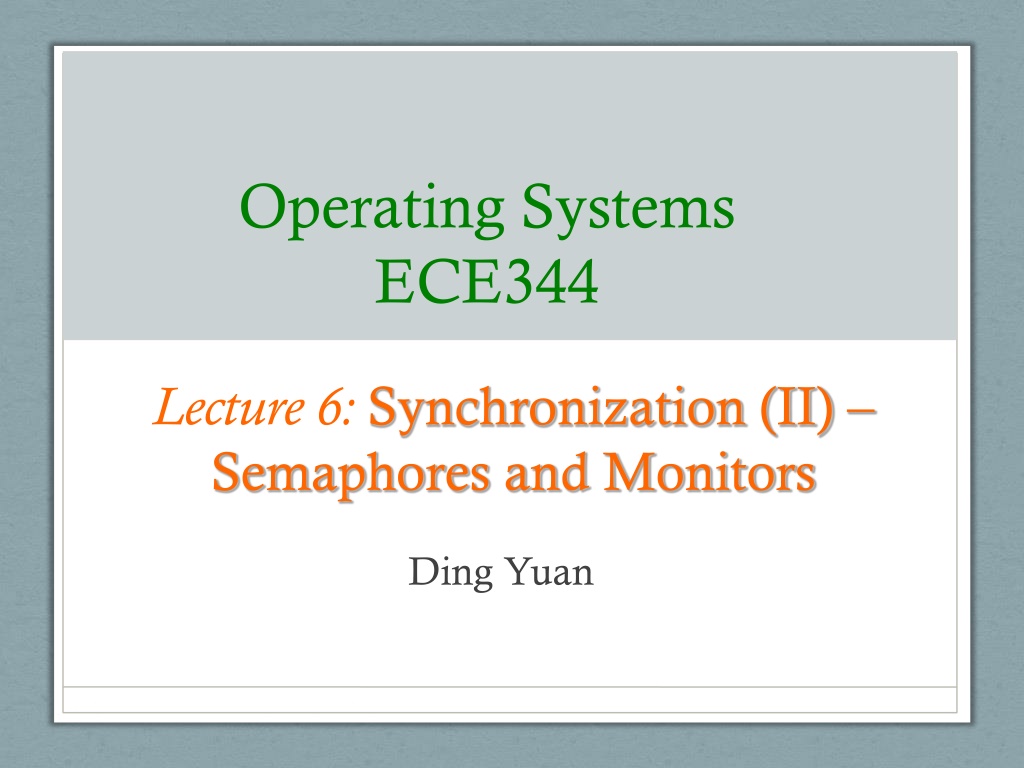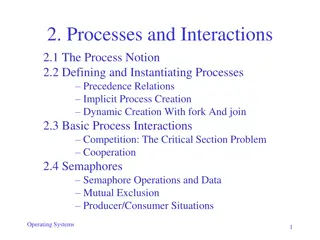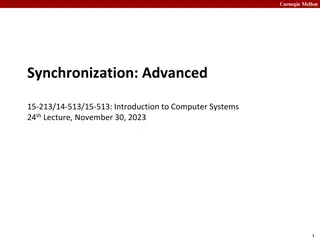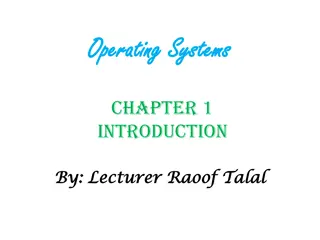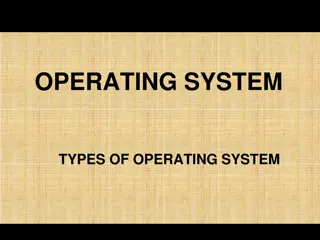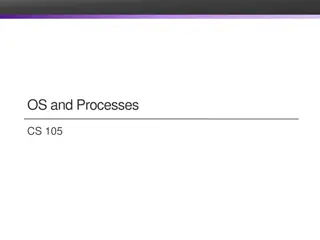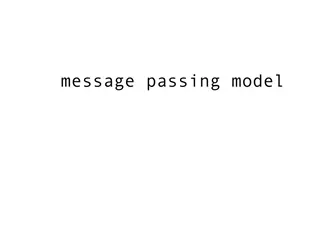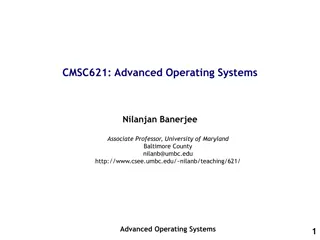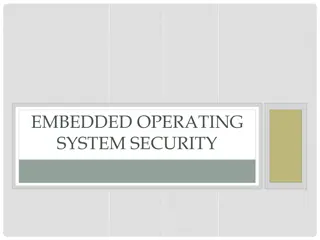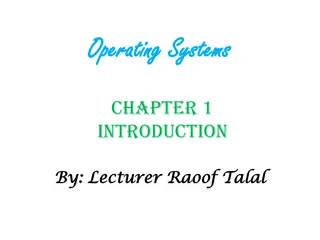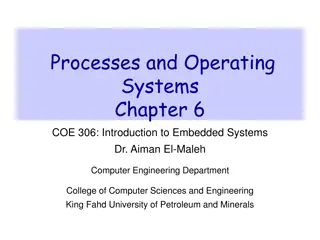Semaphores in Operating Systems
Semaphores are a higher-level synchronization mechanism used in operating systems to manage critical regions. They provide mutual exclusion and can also function as atomic counters. Semaphores have two main operations - wait and signal - to control access to shared resources. By blocking waiters and enabling interrupts within critical sections, semaphores help in avoiding race conditions and ensuring thread safety.
Download Presentation

Please find below an Image/Link to download the presentation.
The content on the website is provided AS IS for your information and personal use only. It may not be sold, licensed, or shared on other websites without obtaining consent from the author.If you encounter any issues during the download, it is possible that the publisher has removed the file from their server.
You are allowed to download the files provided on this website for personal or commercial use, subject to the condition that they are used lawfully. All files are the property of their respective owners.
The content on the website is provided AS IS for your information and personal use only. It may not be sold, licensed, or shared on other websites without obtaining consent from the author.
E N D
Presentation Transcript
Operating Systems ECE344 Lecture 6: Synchronization (II) Semaphores and Monitors Ding Yuan
Higher-Level Synchronization We looked at using locks to provide mutual exclusion Locks work, but they have some drawbacks when critical regions are long Spinlocks inefficient Disabling interrupts can miss or delay important events Instead, we want synchronization mechanisms that Block waiters Leave interrupts enabled inside the critical section Look at two common high-level mechanisms Semaphores: binary (mutex) and counting Monitors: mutexes and condition variables Use them to solve common synchronization problems 2 Ding Yuan, ECE344 Operating System
Semaphores Semaphores are an abstract data type that provide mutual exclusion to critical region Semaphores can also be used as atomic counters More later Semaphores are integers that support two operations: wait(semaphore): decrement, block until semaphore is open Also P(), after the Dutch word for test, or down() signal(semaphore): increment, allow another thread to enter Also V() after the Dutch word for increment, or up() That's it! No other operations not even just reading its value exist P and V are probably the most unintuitive names you encounter in this course and you have Edsger W. Dijkstra to thank to Semaphore safety property: the semaphore value is always greater than or equal to 0 3 Ding Yuan, ECE344 Operating System
Blocking in Semaphores Associated with each semaphore is a queue of waiting processes/threads When P() is called by a thread: If semaphore is open (> 0), thread continues If semaphore is closed, thread blocks on queue Then V() opens the semaphore: If a thread is waiting on the queue, the thread is unblocked What if multiple threads are waiting on the queue? If no threads are waiting on the queue, the signal is remembered for the next thread In other words, V() has history (c.f., condition vars later) This history is a counter 4 Ding Yuan, ECE344 Operating System
Semaphores in OS161 V(sem) { Disable interrupts; sem->count++; thread_wakeup (sem); /* this will wake up all the threads waiting on this sem. Why wake up all threads? */ Enable interrupts; } P(sem) { Disable interrupts; while (sem->count == 0) { thread_sleep(sem); /* current thread will sleep on this sem */ } sem->count--; Enable interrupts; } thread_sleep() assumes interrupts are disabled Note that interrupts are disabled only to enter/leave critical section How can it sleep with interrupts disabled? What happens if while (sem->count ==0) is an if (sem- >count != 0) ? 5 Ding Yuan, ECE344 Operating System
Semaphore Types Semaphores come in two types Mutex semaphore (or binary semaphore) Represents single access to a resource Guarantees mutual exclusion to a critical section Counting semaphore (or general semaphore) Represents a resource with many units available, or a resource that allows certain kinds of unsynchronized concurrent access (e.g., reading) Multiple threads can pass the semaphore (P) Number of threads determined by the semaphore count mutex has count = 1, counting has count = N 6 Ding Yuan, ECE344 Operating System
Using Semaphores Use is similar to our locks, but semantics are different struct Semaphore { int value; Queue q; } S; withdraw (account, amount) { P(S); balance = get_balance(account); balance = balance amount; put_balance(account, balance); V(S); return balance; } P(S); balance = get_balance(account); balance = balance amount; P(S); Threads block P(S); critical section put_balance(account, balance); V(S); V(S); V(S); It is undefined which thread runs after a signal 7 Ding Yuan, ECE344 Operating System
Possible Deadlocks with Semaphores Example: Thread 1: share two mutex semaphores S and Q S:= 1; Q:=1; Thread 2: P(Q); P(S); .. .. V(S); V(Q); P(S); P(Q); .. .. V(Q); V(S); 8 Ding Yuan, ECE344 Operating System
Semaphore Summary Semaphores can be used to solve any of the traditional synchronization problems However, they have some drawbacks They are essentially shared global variables Can potentially be accessed anywhere in program No connection between the semaphore and the data being controlled by the semaphore No control or guarantee of proper usage Sometimes hard to use and prone to bugs Another approach: Use programming language support 9 Ding Yuan, ECE344 Operating System
Monitors A monitor is a programming language construct that controls access to shared data Synchronization code added by compiler, enforced at runtime Why is this an advantage? A monitor is a module that encapsulates Shared data structures Procedures that operate on the shared data structures Synchronization between concurrent threads that invoke the procedures A monitor protects its data from unstructured access It guarantees that threads accessing its data through its procedures interact only in legitimate ways 10 Ding Yuan, ECE344 Operating System
Monitor Semantics A monitor guarantees mutual exclusion Only one thread can execute any monitor procedure at any time (the thread is in the monitor ) If a second thread invokes a monitor procedure when a first thread is already executing one, it blocks So the monitor has to have a wait queue If a thread within a monitor blocks, another one can enter Condition Variable What are the implications in terms of parallelism in monitor? 11 Ding Yuan, ECE344 Operating System
Account Example withdraw(amount) balance = balance amount; Monitor account { double balance; Threads block waiting to get into monitor withdraw(amount) double withdraw(amount) { balance = balance amount; return balance; } } withdraw(amount) return balance (and exit) balance = balance amount return balance; When first thread exits, another can enter. Which one is undefined. balance = balance amount; return balance; Hey, that was easy But what if a thread wants to wait inside the monitor? 12 Ding Yuan, ECE344 Operating System
Condition Variables A condition variable is associated with a condition needed for a thread to make progress once it is in the monitor. Monitor M { ... monitored variables Condition c; void enter_mon (...) { if (extra property not true) wait(c); waits outside of the monitor's mutex do what you have to do if (extra property true) signal(c); brings in one thread waiting on condition } 13 Ding Yuan, ECE344 Operating System
Condition Variables Condition variables support three operations: Wait release monitor lock, wait for C/V to be signaled So condition variables have wait queues, too Signal wakeup one waiting thread Broadcast wakeup all waiting threads Condition variables are not boolean objects if (condition_variable) then does not make sense if (num_resources == 0) then wait(resources_available) does An example will make this more clear 14 Ding Yuan, ECE344 Operating System
Condition Vars != Semaphores Condition variables != semaphores However, they each can be used to implement the other Access to the monitor is controlled by a lock wait() blocks the calling thread, and gives up the lock To call wait, the thread has to be in the monitor (hence has lock) Semaphore::P just blocks the thread on the queue signal() causes a waiting thread to wake up If there is no waiting thread, the signal is lost Semaphore::V increases the semaphore count, allowing future entry even if no thread is waiting Condition variables have no history 15 Ding Yuan, ECE344 Operating System
Locks and Condition Vars In OS161, we don t have monitors But we want to be able to use condition variables So we isolate condition variables and make them independent (not associated with a monitor) Instead, we have to associate them with a lock (mutex) Now, to use a condition variable Threads must first acquire the lock (mutex) CV::Wait releases the lock before blocking, acquires it after waking up 16 Ding Yuan, ECE344 Operating System
Using Semaphores We ve looked at a simple example for using synchronization Mutual exclusion while accessing a bank account Now we re going to use semaphores to look at more interesting examples Readers/Writers Bounded Buffers (after we discuss Monitor) 17 Ding Yuan, ECE344 Operating System
Readers/Writers Problem Readers/Writers Problem: An object is shared among several threads Some threads only read the object, others only write it We can allow multiple readers but only one writer Let #r be the number of readers, #w be the number of writers Safety: (#r 0) (0 #w 1) ((#r > 0) (#w = 0)) How can we use semaphores to control access to the object to implement this protocol? 18 Ding Yuan, ECE344 Operating System
First write operational code reader { read; } Does it work? Why? writer { Write; } 19 Ding Yuan, ECE344 Operating System
First attempt: one mutex semaphore // exclusive writer or reader Semaphore w_or_r = 1; Does it work? Why? Which condition is satisfied and which is not? (#r 0) (0 #w 1) ((#r > 0) (#w = 0)) reader { P(w_or_r); // lock out writers read; V(w_or_r); // up for grabs } writer { P(w_or_r); // lock out readers Write; V(w_or_r); // up for grabs } 20 Ding Yuan, ECE344 Operating System
Second attempt: add a counter int readcount = 0; // record #readers Semaphore w_or_r = 1; // mutex semaphore Does it work? readcount is a shared variable, who protects it? reader { readcount++; if (readcount == 1){ P(w_or_r); // lock out writers } read; readcount--; if (readcount == 0){ V(w_or_r); // up for grabs } } Thread 1: Thread 2: reader { readcount++; reader { readcount++; if (readcount == 1){ P(w_or_r); } if (readcount == 1){ P(w_or_r); } A context switch can happen, a writer can come in since no reader locked the semaphore! context switch writer { P(w_or_r); // lock out readers Write; V(w_or_r); // up for grabs } 21 Ding Yuan, ECE344 Operating System
Readers/Writers Real Solution Use three variables int readcount number of threads reading object Semaphore mutex control access to readcount Semaphore w_or_r exclusive writing or reading 22 Ding Yuan, ECE344 Operating System
Readers/Writers // number of readers int readcount = 0; // mutual exclusion to readcount Semaphore mutex = 1; // exclusive writer or reader Semaphore w_or_r = 1; reader { P(mutex); readcount += 1; // one more reader if (readcount == 1) P(w_or_r); // synch w/ writers V(mutex); // unlock readcount Read; P(mutex); // lock readcount readcount -= 1; // one less reader if (readcount == 0) V(w_or_r); // up for grabs V(mutex); // unlock readcount} } // lock readcount writer { P(w_or_r); // lock out readers Write; V(w_or_r); // up for grabs } Why do readers use mutex? What if the V(mutex) is above if (readcount == 1) ? 23 Ding Yuan, ECE344 Operating System
But it still has a problem // number of readers int readcount = 0; // mutual exclusion to readcount Semaphore mutex = 1; // exclusive writer or reader Semaphore w_or_r = 1; reader { P(mutex); readcount += 1; // one more reader if (readcount == 1) P(w_or_r); // synch w/ writers V(mutex); // unlock readcount Read; P(mutex); // lock readcount readcount -= 1; // one less reader if (readcount == 0) V(w_or_r); // up for grabs V(mutex); // unlock readcount} } // lock readcount writer { P(w_or_r); // lock out readers Write; V(w_or_r); // up for grabs } 24 Ding Yuan, ECE344 Operating System
Problem: Starvation What if a writer is waiting, but readers keep coming, the writer is starved 25 Ding Yuan, ECE344 Operating System
Semaphore Questions Are there any problems that can be solved with counting semaphores that cannot be solved with mutex semaphores? If a system provides only mutex semaphores, can you use it to implement a counting semaphores? When to use counting semaphore? Problem needs a counter The maximum value is known (bounded) 26 Ding Yuan, ECE344 Operating System
Monitor Readers and Writers Will have four methods: StartRead, StartWrite, EndRead and EndWrite Monitored data: nr (number of readers) and nw (number of writers) with the monitor invariant (nr 0) (0 nw 1) ((nr > 0) (nw = 0)) Two conditions: canRead: nw = 0 canWrite: (nr = 0) (nw = 0) 27 Ding Yuan, ECE344 Operating System
Monitor Readers and Writers Monitor RW { int nr = 0, nw = 0; Condition canRead, canWrite; void StartWrite { while (nr != 0 || nw != 0) do wait(canWrite); nw++; } void StartRead () { while (nw != 0) do wait(canRead); nr++; } void EndWrite () { nw--; broadcast(canRead); signal(canWrite); void EndRead () { nr--; if (nr == 0) signal(canWrite); } } // end monitor } 28 Ding Yuan, ECE344 Operating System
Monitor Readers and Writers Is there any priority between readers and writers? What if you wanted to ensure that a waiting writer would have priority over new readers? 29 Ding Yuan, ECE344 Operating System
Bounded Buffer Problem: There is a set of resource buffers shared by producer and consumer threads Producer inserts resources into the buffer set Output, disk blocks, memory pages, processes, etc. Consumer removes resources from the buffer set Whatever is generated by the producer Producer and consumer execute at different rates No serialization of one behind the other Tasks are independent (easier to think about) The buffer set allows each to run without explicit handoff Safety: Sequence of consumed values is prefix of sequence of produced values If nc is number consumed, np number produced, and N the size of the buffer, then 0 np nc N 30 Ding Yuan, ECE344 Operating System
Bounded Buffer (2) functional code producer { while (1) { Produce new resource; Add resource to an empty buffer; } } consumer { while (1) { Remove resource from a full buffer; Consume resource; } } 31 Ding Yuan, ECE344 Operating System
Bounded Buffer (3) Use three semaphores: empty count of empty buffers Counting semaphore empty = N (np nc) full count of full buffers Counting semaphore np - nc = full mutex mutual exclusion to shared set of buffers Binary semaphore 32 Ding Yuan, ECE344 Operating System
Bounded Buffer (4) Semaphore mutex = 1; // mutual exclusion to shared set of buffers Semaphore empty = N; // count of empty buffers (all empty to start) Semaphore full = 0; // count of full buffers (none full to start) producer { while (1) { Produce new resource; P(empty); // wait for empty buffer P(mutex); // lock buffer list Add resource to an empty buffer; V(mutex); // unlock buffer list V(full); // note a full buffer } } consumer { while (1) { P(full); // wait for a full buffer P(mutex); // lock buffer list Remove resource from a full buffer; V(mutex); // unlock buffer list V(empty); // note an empty buffer Consume resource; } } 33 Ding Yuan, ECE344 Operating System
Bounded Buffer (5) Consumer decrements FULL and blocks when buffer has no item since the semaphore FULL is at 0 34 Ding Yuan, ECE344 Operating System
Bounded Buffer (6) Why we need both empty and full semaphores? Semaphore mutex = 1; // mutual exclusion to shared set of buffers Semaphore empty = N; // count of empty buffers (all empty to start) Semaphore full = 0; // count of full buffers (none full to start) producer { while (1) { Produce new resource; P(empty); // wait for empty buffer P(mutex); // lock buffer list Add resource to an empty buffer; V(mutex); // unlock buffer list V(full); // note a full buffer } } More consumers remove resource than actually produced! consumer { while (1) { P(full); // wait for a full buffer P(mutex); // lock buffer list Remove resource from a full buffer; V(mutex); // unlock buffer list V(empty); // note an empty buffer Consume resource; } } 35 Ding Yuan, ECE344 Operating System
Monitor Bounded Buffer Monitor bounded_buffer { Resource buffer[N]; // Variables for indexing buffer // monitor invariant involves these vars Condition not_full; // space in buffer Condition not_empty; // value in buffer Resource get_resource() { while (buffer array is empty) wait(not_empty); Get resource R from buffer array; signal(not_full); return R; } } // end monitor void put_resource (Resource R) { while (buffer array is full) wait(not_full); Add R to buffer array; signal(not_empty); } What happens if no threads are waiting when signal is called? Signal is lost 36 Ding Yuan, ECE344 Operating System
Monitor Queues Monitor bounded_buffer { Condition not_full; other variables Condition not_empty; Waiting to enter Waiting on condition variables void put_resource () { wait(not_full) signal(not_empty) } Resource get_resource () { } } Executing inside the monitor 37 Ding Yuan, ECE344 Operating System
Summary Semaphores P()/V() implement blocking mutual exclusion Also used as atomic counters (counting semaphores) Can be inconvenient to use Monitors Synchronizes execution within procedures that manipulate encapsulated data shared among procedures Only one thread can execute within a monitor at a time Relies upon high-level language support Condition variables Used by threads as a synchronization point to wait for events Inside monitors 38 Ding Yuan, ECE344 Operating System
